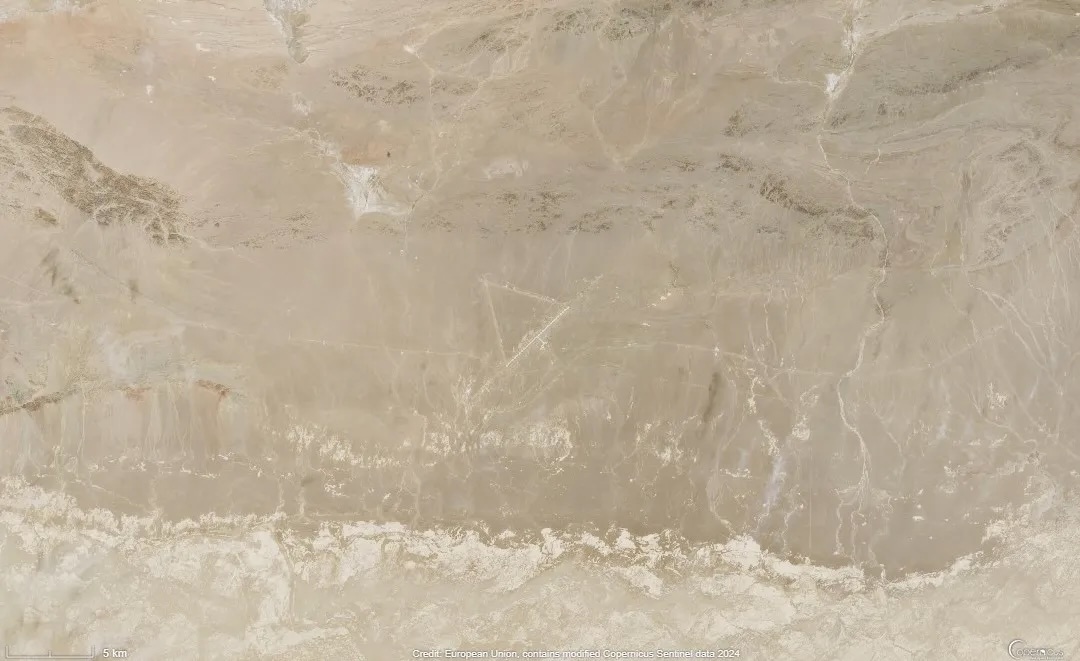7.09.2024

Sentinel 2 L2A satellite imagery showing the triangle area at Lop Nur where China's reusable spaceplane is thought to land. Credit: European Union/modified Copernicus Sentinel data 2024
HELSINKI — China’s experimental reusable spaceplane returned to Earth late Thursday, completing its third orbital mission.
State media Xinhua issued a brief report on Sept. 5 (Eastern), confirming the spacecraft’s return to Earth. The report provided no images, nor information regarding the mission and its landing site.
The “success of the experiment demonstrates the growing maturity of China’s reusable spacecraft technologies, which will pave the way for more convenient and affordable round-trip methods for the peaceful use of space in the future,” the report read.
China launched the spacecraft from Jiuquan spaceport on a Long March 2F rocket for the third time Dec. 14. That event took place two weeks ahead of the launch of the U.S. X-37B spaceplane on a Falcon Heavy rocket into an undisclosed orbit. China’s spaceplane is thought to be analogous to the X-37B.
Astrophysicist and space watcher Jonathan McDowell estimates the spacecraft would have passed over the expected Lop Nur landing site in Xinjiang Autonomous Region, northwestern China, at around 9:10 p.m. Eastern, Sept. 5.
Observations of the spacecraft’s maneuvers in orbit suggested the spacecraft was preparing for a return to Earth. In late July, amateur optical astronomy revealed images of the spacecraft in orbit.
The landing marked the completion of the spaceplane’s third mission. At 267 days, it was similar in duration to the second mission, which lasted 276 days. The initial flight in 2020 lasted two days.
Rendezvous and proximity operations
All missions have involved releasing a small satellite or object into orbit. The second and third missions have seen the main spacecraft appear to conduct rendezvous and proximity operations (RPO) with the object it released. The third flight saw RPOs conducted in June.
While it is unclear if the spaceplane briefly retrieved and re-released the object, their close approach suggests intentional proximity operations. The second mission also involved RPOs. Such operations could be useful for retrieving, repairing and maintaining friendly satellites, or potentially nefarious counterspace operations against an adversary’s spacecraft.
China has maintained strict secrecy around the mission. The country’s space authorities have not released images nor descriptions of the spacecraft.
The short Chinese reports on the mission state that the spacecraft is for reusable technology verification and space science experiments, and will “provide technical support for the peaceful use of space.”
The orbital reusable spacecraft is intended to work in conjunction with a reusable suborbital first stage. This suborbital craft, which uses vertical takeoff and horizontal landing, was first tested in 2021. A second mission flew in August 2022.
The China Aerospace Science and Technology Corporation (CASC), which developed the spacecraft, announced plans for a fully reusable, two-stage-to-orbit (TSTO) space transportation system before the first launch. In 2022, CASC’s spaceplane project received national funding from the Natural Science Foundation of China.
The system’s development fits into a broader trend of China pushing to increase its access to space and developing reusable solutions for spaceflight. The amount of time between landing and the next launch of the vehicle could provide some insight into progress on reusability.
| Mission | Launch Date | Landing Date | Duration | Time Since Previous Mission | Launch Site | Landing Site |
|---|---|---|---|---|---|---|
| Mission 1 | September 4, 2020 | September 6, 2020 | 2 days | N/A | Jiuquan | Lop Nur air base |
| Mission 2 | August 4, 2022 | May 8, 2023 | ~276 days | 1 year, 11 months | Jiuquan | Lop Nur air base |
| Mission 3 | December 14, 2023 | September 6, 2024 | ~267 days | 7 months, 6 days | Jiuquan | Lop Nur air base (likely) |
